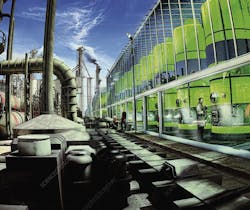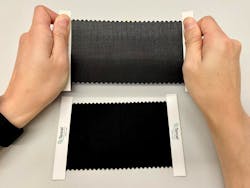Released in December 2023, the annual market development report from European Bioplastics shows overall global bioplastic production picking up.
The trade body says this follows a period of largely COVID-19-induced stagnation, but now rising demand, and the emergence of more sophisticated applications and products is driving the market upward.
So much so that the report predicts an increase in global bioplastics production from around 2.18 million metric tons in 2023 to approximately 7.43 million metric tons in 2028.
In particular, production capacities of polymers such as polylactic acid (PLA), polyhydroxyalkanoates (PHA), polyamides (PA) and polypropylene (PP) will continue to increase significantly over the next five years, according to the data.
Bioplastics are found in an increasing variety of applications, ranging from packaging and consumer products to electronics, automotive and textiles. Packaging remains the largest market segment for bioplastics, with 43% (934,000 metric tons) of the total bioplastics market in 2023.
For the first time, the report includes production data. Although varying from one polymer to another, the average plant utilization rate in 2023 was 82%.
The report also noted that bioplastic alternatives exist for almost every conventional plastic material and corresponding application.
Bioplastics are found in an increasing variety of applications, ranging from packaging and consumer products to electronics, automotive and textiles. Packaging remains the largest market segment for bioplastics, with 43% (934,000 metric tons) of the total bioplastics market in 2023.
A study in a recent issue of Current Opinion in Green and Sustainable Chemistry by researchers from the University of KwaZulu Natal and the Council for Scientific and Industrial Research in South Africa delves more deeply.
They emphasize the industry's focus on producing environmentally friendly products with a smaller carbon footprint while meeting the properties of existing market products.
The authors stress the vital role of research and development in advancing bio-based chemicals, given their lower maturity compared to traditional petrochemical production methods. Addressing bottlenecks in key processing stages is critical. These include saccharification of waste material to ensure the valorisation process is successful, optimizing the fermentation processes with shorter runs and higher yields and advancing more efficient, cost-effective downstream purification methods.
It’s also important to determine the commercial feasibility of new processes through scaling up, economic analysis and lifecycle analyses, the authors state.
How NatureWorks Turns Plants Into Plastics
Most of the emphasis on bio-based chemicals revolves around eco-friendly plastics, with PLA taking the lead due to its widespread availability and attractive cost structure.
Here, the South African researchers single out the efforts of NatureWorks in Plymouth, Minnesota, whose current production capacity of 150,000 t/yr PLA will rise by another 75,000 t/yr when its Nakhon Sawan Biocomplex in Nakhon Sawan Province, Thailand, comes online in 2025.
According to NatureWorks, the new facility is progressing as planned, with the melt crystallizer now being installed. It will produce the full portfolio of the company’s Ingeo PLA grades, with a particular eye on growth markets including 3D printing and hygiene as well as compostable coffee capsules, tea bags, flexible packaging and food serviceware.
The company currently uses plants, such as corn, cassava, sugar cane or beets to capture and sequester CO2 and transform it into long-chain sugar molecules.
To do this, the company mills the plants to extract starch (glucose), which it then hydrolizes to dextrose with enzymes before microorganisms ferment this into lactic acid.
A proprietary two-step process transforms lactic acid molecules into rings of lactide, which is a valuable chemical on its own and the core of the company’s customizable platform of chemical intermediates.
The final step is polymerization, which opens the lactide rings and links them together to form the long chain of polylactide polymer the company calls Ingeo.
NatureWorks says its R&D team is assessing new technologies that would allow it to skip the use of plants and use microorganisms directly to convert greenhouse gases into lactic acid.
Running the Bio-Based LAPP
When international cable and connection technology company LAPP wanted to further reduce its carbon footprint it turned to BASF’s new bio-based plastic sheathing.
LAPP, based in Stuttgart, Germany, had been using thermoplastic polyurethane (TPU) sheathing made from fossil fuel-based ingredients, including a polyol or long-chain diol, a chain extender and diisocyanate.
BASF’s bio-based TPU replacement, known as Elastollan N, biopolymer made from corn. Depending on the type of TPU needed – adhesion, transparency, durability and other requirements vary from application to application – the proportion of renewable raw material can vary from 45%-60%.
The new TPU has the same durability, flexibility and mechanical properties, plus resistance to hydrolysis, UV and chemicals, as BASF’s conventional Elastollan, according to LAPP. The two are equally processable, too.
BASF maintains that a special feature of Elastollan N is that the proportion of biomaterial in the finished product can both be detected and precisely measured in line with the ASTM D 6866 bio-based testing standard.
This widely adopted standard provides accurate measurements of bio-based/biogenic carbon content in materials derived from sources that were in direct equilibrium with atmospheric carbon dioxide at the time of respiration or metabolism cessation, such as during crop harvesting or the natural lifecycle of grass in a field.
LAPP conducted a lifecycle assessment (LCA) that showed the new product cuts its carbon footprint by approximately 15%, a figure the company hopes to improve on as its strategy to expand its portfolio of bio-based sheath materials kicks in, according to a April 2023 news release announcing the partnership with BASF.
Another chemical company supplying bio-based TPU is Lubrizol Corp. The company has a renewable content that varies from 30%–70%. Lubrizol says Bio TPU's performance and benefits are comparable to and sometimes even better than traditional petroleum-based TPU.
The company also has launched a grade with 67% bio-based content, meeting ASTM D 6866 certification, for use in high-performance hot-melt reactive adhesives.
And in January, Austrian company Lenzing announced a new processing technique for its wood-based Tencel Lyocell fibers to make them an alternative material for stretch fabrics.
It involves re-engineering woven fabric made of the fibers, coupled with a fabric pre-treatment step.
During a wet process, the fibers undergo a significant swelling in diameter, according to the company. The increased width of the yarn causes crimping, resulting in a fabric that recovers well from stretching, without shrinking or wrinkling easily.
A fossil-free alternative to conventional synthetic materials, Tencel Lyocell fibers used in the stretch fabrics come from controlled or certified wood sources and are made from a resource-saving closed-loop production process. Additionally, the fibers are identifiable in end products and traceable back to their sources, ensuring greater accountability and transparency in the supply chain.
The company is taking its new development a step further by extending support to mill partners who use its fibers. The fabrics the company makes will meet international standards for fabric stretch and recovery properties, while giving the mills and associated brands the chance to produce new designs in sportswear, leisure, loungewear and home textiles, the company says.
“We are committed to fostering responsible production practices through innovations in the textile sector and are delighted to share this latest innovative development with our fabric mill partners,” noted Rex Mok, Lenzing’s vice president of fiber technical marketing and development, in a news release. “Together, we are taking a significant stride towards reduced usage of fossil-based materials within the textile value chain while ensuring comfort and material performance.”
Green Validation: LCAs, Recycling and BioPBS Certification
As LAPP’s TPU shows, LCAs remain a crucial step in any validation of bio-based chemicals.
In January, Netherlands-based TotalEnergies published the LCA for its recycled Luminy PLA.
It considers seven impact categories, including global warming potential (GWP), water consumption and land use.
The assessment found that advanced recycling of PLA as a production process has a lower impact compared to its production from virgin feedstock.
Specifically, the GWP of Luminy 30% PLA, considering its biogenic carbon content, is 0.19 kg of CO2/kg of PLA, whereas virgin Luminy PLA emits 0.51 kg of CO2/kg of PLA.
The company’s assessment highlights the importance of considering the temporary carbon storage in products, which is key for bio-based materials. By analyzing the carbon cycle for both bio-based and fossil-based products, the report emphasizes the role of biogenic carbon content in PLA. Recycling PLA allows a longer storage of this biogenic carbon which is originally from the atmosphere.
Notably, when factoring in biogenic carbon content, the GWP of 30% recycled PLA is reduced by 300 kgCO2/PLA compared to virgin PLA, marking a significant step toward achieving global climate targets.
A product achieves certification as marine biodegradable biomass plastic if it includes 25% or more biomass plastic.
Maelenn Ravard, regulatory and sustainability manager at TotalEnergies Corbion, underscores the significance of advanced recycling, stating, "Depolymerizing PLA via hydrolysis is an energy-efficient process allowing us to close the loop and increase circularity for a bio-based material. The LCA results only confirm this statement."
In December, the Mitsubishi Chemical Group announced that its plant-derived compostable polymer BioPBS received certification as a marine biodegradable biomass plastic under the marine biodegradable plastic identification and labeling system established by the Japan BioPlastics Association (JBPA).
This regularly revised list covers three categories: biodegradable synthetic polymers and compostable synthetic polymers; additives; and others such as compostable synthetic polymers to which additives have been added.
A product achieves certification as marine biodegradable biomass plastic if it includes 25% or more biomass plastic.
BioPBS is bio-based polybutylene succinate produced from polymerization of bio-based succinic acid and 1,4-butanediol. A soft, flexible and semi-crystalline polyester, it is commonly used in injection moulding.
MCG Group says that compared to other compostable polymers, it shows excellent performance characteristics, such as low-temperature heat sealability and flexibility, making it suitable for various applications, including food packaging, cutlery and fishing equipment.
The company plans to use certification as a springboard to further expand the market for BioPBS.
Convincing the Lawmakers
The future of bio-based chemical products is in the hands of lawmakers, raising additional challenges for the industry.
For example, the EUPB is critical of EU environment ministers, who it says failed to acknowledge the value of innovations in bio-based and compostable plastics packaging at an Dec. 18 European Council meeting in Brussels, Belgium.
The meeting spelled out the ministers’ latest thinking on the EU’s proposed packaging and packaging waste regulation legislation.
The agreed approach aims to harmonize the internal packaging market, combat the escalating issue of packaging waste and foster a circular economy.
As part of this, the council mandated the compostability of tea bags and sticky labels on fruits and vegetables but has provided member states an option to require other packaging, such as coffee pods and light-weight plastic carrier bags, to be compostable under specific conditions.
“It is a weak general approach, barely recognizing the value of a very short number of compostable applications and hindering bio-based innovative solutions,” says Roberto Ferrigno, EUPB’s head of EU affairs. “Disagreement among governments, and derogations on several important measures will result in further fragmentation of the internal market.”
About the Author
Seán Ottewell
Editor-at-Large
Seán Crevan Ottewell is Chemical Processing's Editor-at-Large. Seán earned his bachelor's of science degree in biochemistry at the University of Warwick and his master's in radiation biochemistry at the University of London. He served as Science Officer with the UK Department of Environment’s Chernobyl Monitoring Unit’s Food Science Radiation Unit, London. His editorial background includes assistant editor, news editor and then editor of The Chemical Engineer, the Institution of Chemical Engineers’ twice monthly technical journal. Prior to joining Chemical Processing in 2012 he was editor of European Chemical Engineer, European Process Engineer, International Power Engineer, and European Laboratory Scientist, with Setform Limited, London.
He is based in East Mayo, Republic of Ireland, where he and his wife Suzi (a maths, biology and chemistry teacher) host guests from all over the world at their holiday cottage in East Mayo.



